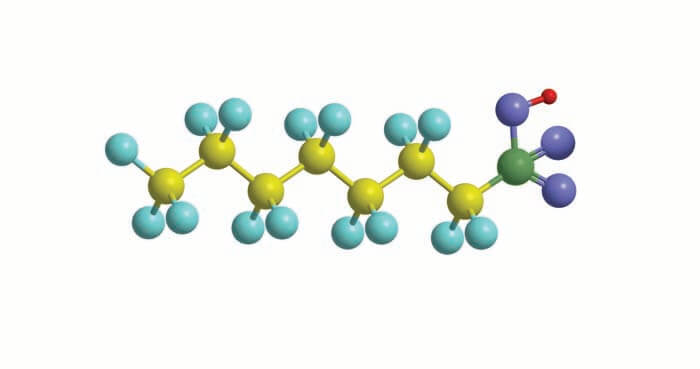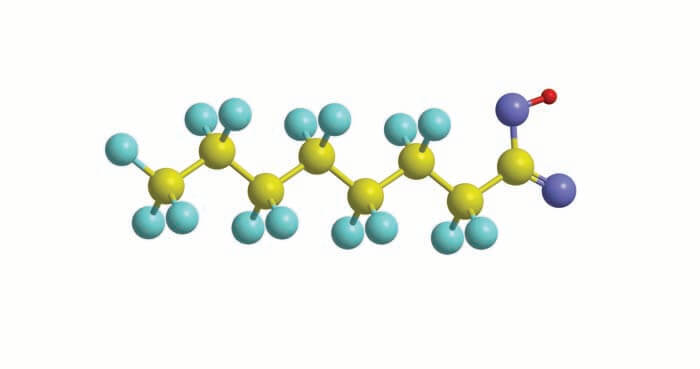
PFOS = perfluorooctane sulfonate, yellow - carbon, teal - flourine, purple - oxygen, red - hydrogen, green - sulfer
PFAS compounds have been “emerging contaminants” for a few years now. It seems this last year has reached a critical point for environmental investigation and sampling for this large group of fluorinated polymers. The number of calls we receive about sampling for PFAS has steadily increased during the last two years. Many groups and agencies have been releasing guidance documents about PFAS compounds and PFAS sampling protocols (see geoprobe.com/PFAS).
What are PFAS?
PFAS consist of a large group of fluorinated polymers used in many commercial and industrial products. This includes any of the Teflon® polymers used in common household products like your frying pan, PTFE plumber’s tape, your Goretex-lined rain coat, or the water/stain resistant coating on your carpet or couch. One of the primary concerns for these polymers relates to Aqueous Fire Fighting Foams (known as AFFF, AF3, or A triple F). The Department of Defense (DOD) has used these foams to fight/control fires at air bases and also used in fire training. Many commercial airports and some municipal fire departments have also used AFFF. These fire-fighting foams contain several of the PFAS polymers, including PFOA and PFOS.
EPA Guidelines
The Federal Environmental Protection Agency (EPA) has set a Health Advisory Level for PFOA + PFOS at 70 parts per trillion – yes, parts per trillion. This advisory level is about 100 times lower than any previous maximum contaminant level set by the EPA. This means that the potential for cross contamination of samples by commonly used products during field sampling becomes a significant concern. These products range from the Rite-in-the-Rain notebooks, to Tyvek suits, sunscreen, bug spray, Teflon® liners of many sample bottle caps, and more.
Geoprobe® Sampler Analysis and Advice
A few laboratories have started programs to verify whether many of these products are truly a significant concern for PFAS cross-contamination. Jennifer Field, Ph.D., at Oregon State University (OSU) leads one of the research teams. Geoprobe® submitted samples of our clear PVC soil liners and lay flat liners used for sonic soil sampling to OSU. Field’s team analyzed the Geoprobe® soil liners for 24 PFAS analytes, including PFOS and PFOA. Field and her team are preparing to publish the results of their analyses soon. Geoprobe® will provide links to the article on our webpage as soon as we learn it has been published.
Preliminary results indicate all of the Geoprobe® soil liners are below the reporting limit for all 24 PFAS compounds for which they were tested. These results are for a single sampling event, so we get a snapshot in time about PFAS results for the liners.
Geoprobe® recommends you conduct periodic field rinsate samples of tools and soil liners during your PFAS sampling projects. You must use PFAS free water provided by your laboratory for this purpose. Tap water or bottled water may have been in contact with PFAS containing materials such as Teflon® tape or PTFE containing pipe joint compound. Of course, use bottles (HDPE or Polypropylene) provided by your lab for the PFAS field rinsate samples.
The steel components of soil samplers and groundwater sampling tools do not contain PFAS compounds. Use of these tools for PFAS sampling and investigation following standard procedures is appropriate. Be careful to NOT use materials like Teflon® tape or PTFE joint compound on joints or fittings that will have sample contact. Don’t use Teflon® soil liners or tubing in your sampling for PFAS. Use the clear PVC soil liners when soil sampling or HDPE or polypropylene tubing when groundwater sampling. The DOD has recommended the use of silicon-based plumbers paste and O-rings in place of Teflon® products. Also, the DECON 90 product contains PFAS components so use decon soap and water approved for PFAS sampling. We are all coming up the PFAS learning curve. As the entire industry continues to learn about PFAS sampling, analysis, and remediation, updates and revisions to guidance documents and operating procedures will be issued.
Links
https://www.epa.gov/ground-water-and-drinking-water/drinking-water-health-advisories-pfoa-and-pfos
https://pfas-1.itrcweb.org/fact-sheets/
https://www.epa.gov/water-research/pfas-methods-and-guidance-sampling-and-analyzing-water-and-other-environmental-media
https://www.epa.gov/sites/production/files/2019-02/documents/pfas_methods_tech_brief_28feb19_update.pdf
Contact Us
1835 Wall Street
Salina, Kansas 67401
Phone: (785) 825-1842
Photo Gallery




